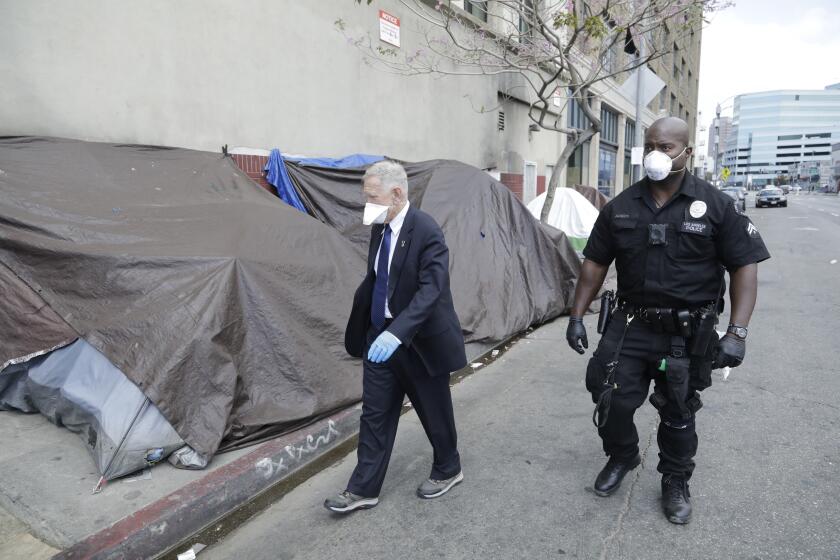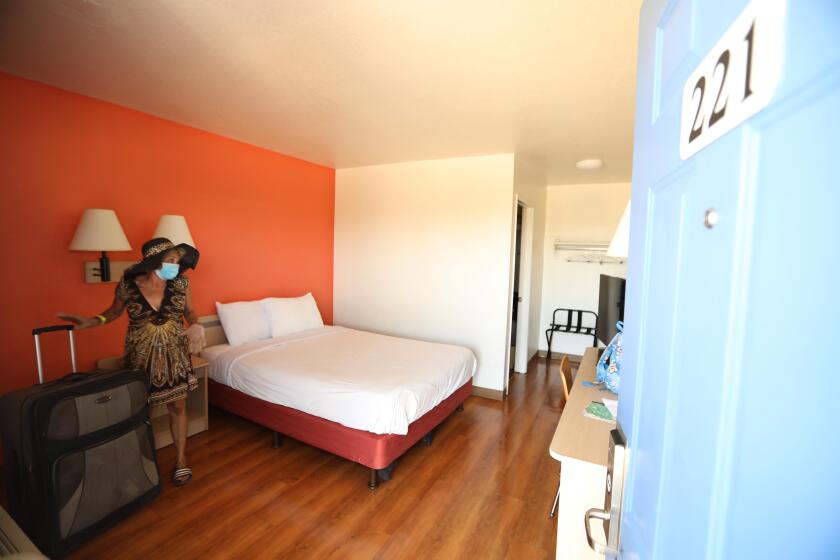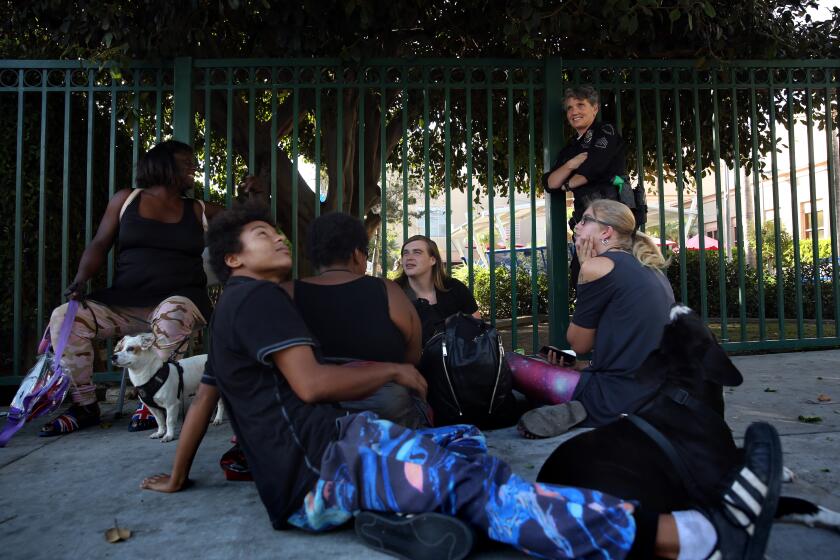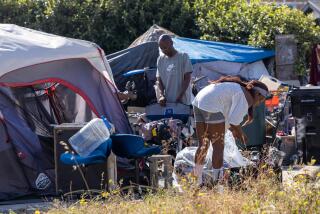This year’s homeless count was canceled. Is it time to rethink it?
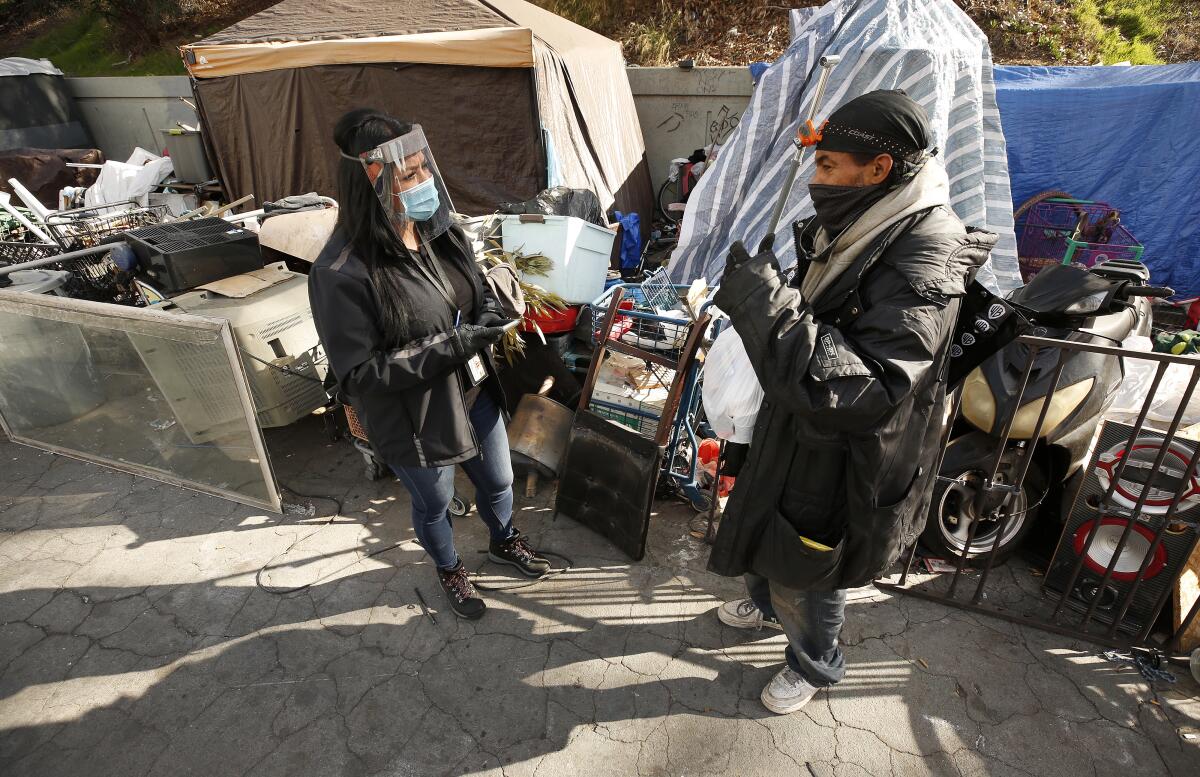
- Share via
Los Angeles County’s annual homeless count is a civic ritual bringing thousands of volunteers together in a common cause. It is also a reckoning with the shortcomings of all that’s been done to salve the county’s most perplexing human crisis.
So its cancellation this year due to the risk of spreading the coronavirus has had a multifaceted fallout — a loss of civic engagement, uncertainty over how much the COVID-19 pandemic has added to homelessness and, possibly most consequential, the potential loss of federal dollars that would be triggered by a higher count.
But for those who see sharp and timely data as a keystone in the fight against homelessness, the hiatus has created an opportunity to reimagine a process that is inherently blunt and slow.
“Is now a time to really look at a way to do the count differently?” asked Jennifer Hark-Dietz, deputy chief executive officer and executive director of PATH, a statewide homeless housing and services agency. “I love the idea of a data system that kind of replaces this three-day count, to some degree.”
The flaws in the annual count are manifest. It occurs only once a year, at best yielding a snapshot of homelessness on three days and nights in January.
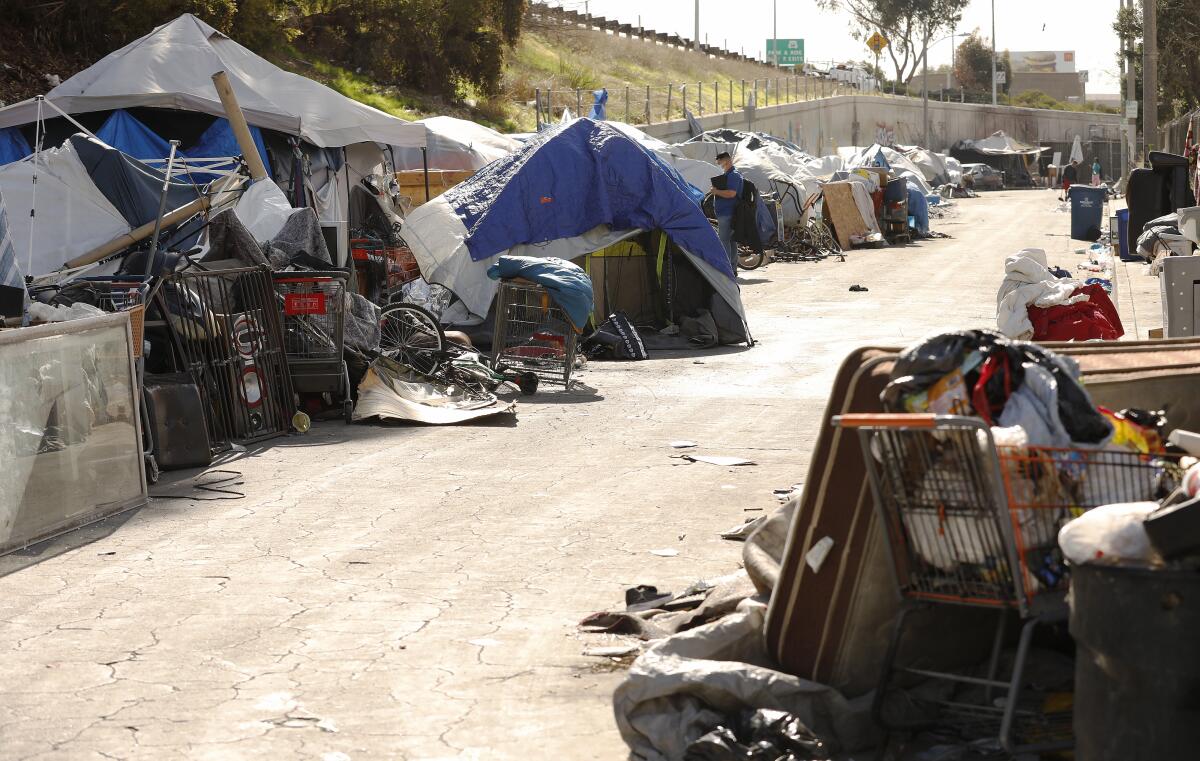
But that snapshot can’t be seen until four or five months later, after a field survey and statistical analysis that is subject to various types of error and changes of methodology. Also problematic: The numbers become less accurate as the data are sliced into smaller areas.
The Los Angeles Homeless Services Authority, which conducts the count, breaks out estimates by city and census tract, but not for pinpoint locations.
“You should know how many people are on the beach today as opposed to last year,” said Rick Cole, a veteran local official who has been city manager of several cities and advised L.A. Mayor Eric Garcetti on homelessness. “You should know how many folks are at Lincoln Park.”
A wet week in L.A. has left a federal judge outraged by the conditions homeless people face and the city’s apparent inaction.
Some homeless services providers think that could be done with existing data. The federally mandated Homeless Management Information System, used by outreach workers and case managers to track their clients, contains information on 69,000 people in Los Angeles County, including their locations, mental and physical conditions and notes on what’s being done for them — applying for Social Security, a driver’s license or subsidized housing.
At best, the information they enter into the data system is incomplete, said Janey Rountree, executive director of the California Policy Lab at UCLA, a research group that analyzes data for the Los Angeles Homeless Services Authority.
Since the system only has information about people who are known to outreach workers, it leaves some homeless people out. The street count is still needed to show how homelessness is trending, she said.
But others see the database as an untapped resource.
“We have so much rich data that the outreach workers are tracking,” Hark-Dietz said. “And it seems like an opportunity for us to look at that system and see if maybe there are tweaks we need to do in order to get a more accurate number.”
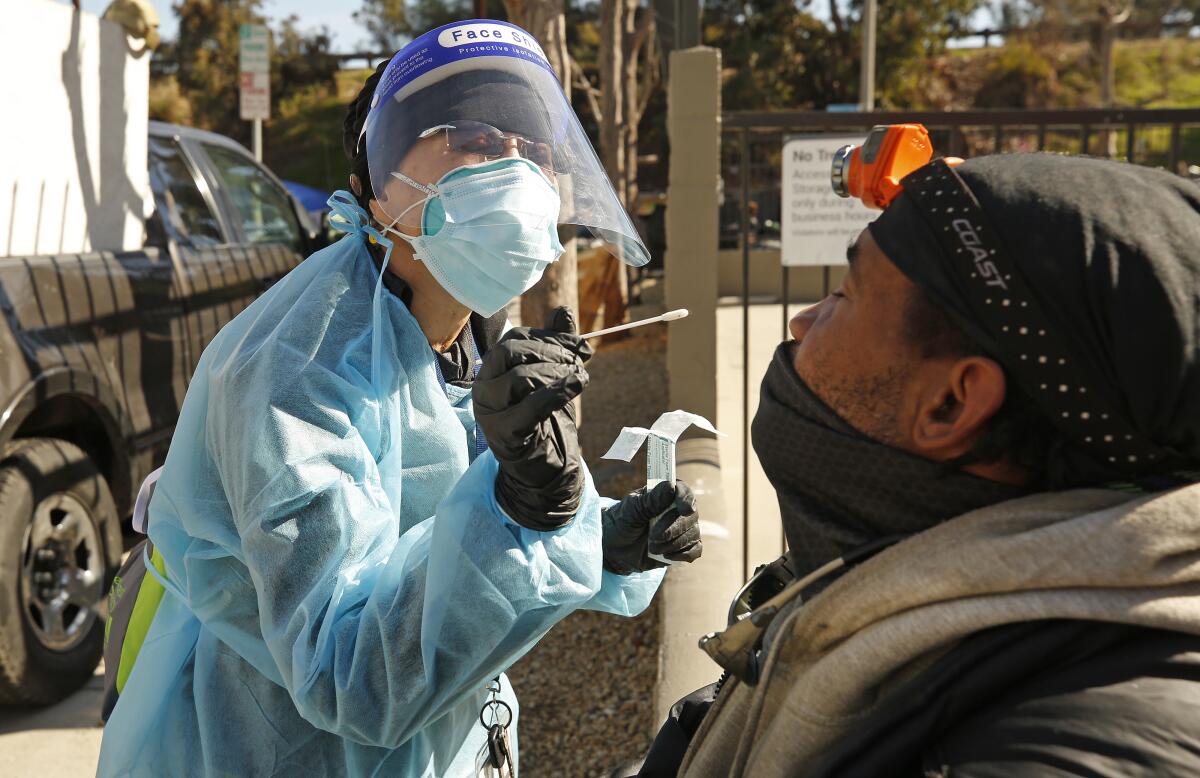
That’s exactly what’s happening in other places, said Beth Sandor, co-director of Built for Zero, a national organization that works with homeless officials in 84 communities, not including Los Angeles.
She contends the human and financial resources L.A. expends on the count would be better used to provide what she calls “actionable” information.
“The first question is, ‘Why we are collecting this information and what are we using it for?’” she said. Besides helping individuals, it’s “so we can know how we are doing in real time. Are all our investments and strategies adding up to help end homelessness?”
Built for Zero communities — including Jacksonville, Fla.; Maricopa County, Ariz.; and Denver — produce monthly reports tracking the number of homeless people in their areas, how many are new to the system, how many exited and whether they obtained housing or just disappeared.
LAHSA’s executive director, Heidi Marston, said in an email response to questions from The Times that the agency is now working on tools that will use existing data to “provide the public with updated information on the state of homelessness and our system’s performance.” She expects these tools to be available later this year.
An executive order signed by President Biden last week changed federal funding rules in a way that could potentially lift thousands of homeless Angelenos off the streets as the coronavirus continues to rage.
But that won’t take the place of the annual count, which is federally mandated, she said.
Sandor said that Built for Zero has urged the federal Department of Housing and Urban Development to allow communities to submit reports from their homeless information systems in lieu of a physical count. During the pandemic, HUD has moved a step in that direction, accepting data from communities that can show it is “comprehensive,” said spokeswoman Meaghan Lynch.
That’s a high bar for sprawling Los Angeles County, where there are hundreds of camps, outreach workers are stretched thin and not every homeless person cooperates.
During a break in the rain last week, LAHSA’s Marisol Barroso and Jaime Montoya were among a dozen outreach workers joined by three nurses working a blocklong stretch of tents and makeshift shelters beside Interstate 405 in Inglewood.
They used a smartphone app to screen residents for COVID-19 and urge them to be tested for the virus. The app led them through a series of questions that branched off to different triggers depending on the answer— a call to 911, a referral to the county quarantine/isolation system or a screening for temporary housing.
At some tents, no one responded to their calls. Out of 40 to 50 people presumed to be living at the encampment, they were able to screen four. One who showed COVID symptoms declined the referral to isolation.
Meanwhile, Richard Wise, an outreach worker with Catholic Charities’ St. Margaret’s Center in Lennox, spent a good hour on a collapsing chair he brought with him, going over housing options with a disabled client who does not meet the criteria for permanent supportive housing but is physically unable to get around to apply for benefits that could support his rent.
Given the obstacles to collecting data directly from homeless people, efforts are being made to tap other sources.
UberMedia, Inc., a company that harnesses mobile phone data for commercial applications, has demonstrated a public service application that tracks homeless people. Designed to show movement patterns, rather than count individuals, it wouldn’t be a substitute for the physical count. But it shows the potential for new data strategies.
Homeless people shouldn’t need to choose between a cold tent and a virus-riddled shelter.
In his recent stint as Santa Monica’s city manager, Cole set up a system that enlists police, fire and public works employees to record data on homeless people. The city contracted with Akido Labs, a healthcare data management firm, to build a phone app for city employees to track heavy users of public services. It’s integrated with the Westside homeless service providers St. Joseph Center, Step-Up on Second and The People Concern.
When a city employee logs an encounter with anyone in the database, the app automatically sends an alert to a service provider connected to that person.
“I think it’s especially relevant in this era of searching for alternatives to incarceration,” said senior human services analyst Brian Hardgrave. “This person’s behavior is problematic, but is there some other person who could come out and get them to whatever the next step is?”
Over the last half of 2019, the system recorded 744 police and fire encounters with 120 people in the database, Hardgrave said.
LAHSA, has similar sources of real-time data.
One is an online tool called LA-HOP. It allows anyone to request an outreach worker to respond to a homeless person. In its 2½ years, LA-HOP has received 26,000 reports.
LAHSA also contracted with Akido Labs early in the pandemic to build the Hot Spot database that Barroso and Montoya were using.
Colleen Murphy, LAHSA’s manager of coordinated system access, said 38,000 surveys have been taken. They are compiled daily into a report the agency uses to alert the Department of Health Services to outbreaks.
In her email reply, Marston said all these sources will be used in the new tools being developed this year.
For Hark-Dietz of PATH, that will be a welcome step forward. But, diverging from those who believe the annual count should be abandoned, she looks forward to its return.
“It is an opportunity to connect community members to the work that we do,” she said. “I think those are really irreplaceable moments where you are able to decrease the stereotypes and really share with folks, just that homelessness can happen to anyone.”
More to Read
Sign up for Essential California
The most important California stories and recommendations in your inbox every morning.
You may occasionally receive promotional content from the Los Angeles Times.
